It is difficult indeed, to write a few pages on a city that is so varied, so immense and so dramatic, says Farzana Contractor, who went forward only to make a journey back in time...
When you stand at the Mount of Olives facing the classic panorama which puts the entire Old City of Jerusalem with the golden Dome of the Rock right in the foreground, you really stop thinking. It�s as if time stands still, and you sink into yourself, mesmerized, is this for real?
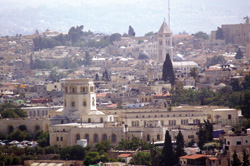 |
| The Jerusalem skyline.
|
Even though the word unique which we use so loosely most of the times, does not fully suffice to describe this city, Jerusalem can stake a claim on it. It is too unique a city. A mountainous walled city with a 5000 year history, it is sacred to people of three religions of the world: Jews, Muslims and Christians.
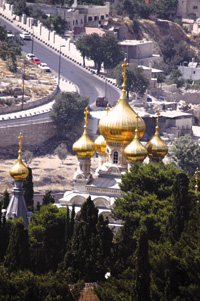 |
| The Russian temple in Jerusalem. |
The focal point of any visit to Jerusalem is the one-square-kilometer walled Old City, with its four residential quarters, Christian, Muslim, Jewish and Armenian. It is a fascinating maze of narrow alleys, one leading to the other, full of little shops selling unusual things, restaurants with exciting aromas, men in different kinds of traditional attire - overall a sensual mix of exotic sights, sounds, and smells.
Jerusalem is Israel�s largest city. On the one hand it appears like you are living in the first century and then you step outside the Old City and find yourself in the 21st. Modern hotels, modern housing, modern transportation, modern restaurants and of course modern people. All trying to find their place in the sun, picturesque neighbourhoods and old landmarks, grandly standing besides glistening new chrome and glass office towers and high-rise apartments. But it�s life that combines all aspects of this city. Life that its diverse people give to it, people who came to settle down here, fifty years ago from all corners of the Jewish world.
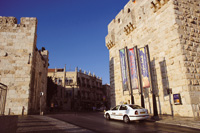 |
| The legendary Jaffa Cafe. |
The two sides of Jerusalem is what makes it a city with two centers of gravity - the downtown area of West Jerusalem (the New City) with its central triangle of Jaffa Road, King George Street, and BenYehuda Street, which is where all the action is on Friday nights as the Sabbath ends. And then there is the famed Old City, the walled city which with its four Quarters is the natural focus of every visitor to the town.
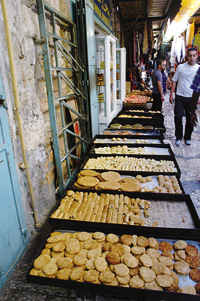 |
| Inside the walled city. |
Here is where you want to return each day that you spend in Jerusalem. Inside the walled city is where you also have the three most holy sites of the three religions.
The Western Wall, Al Aqsa Mosque and the Church of the Holy Sepulchre. Which effectively means Jerusalem is sacred to more than one-third of the world�s population.
The Western Wall
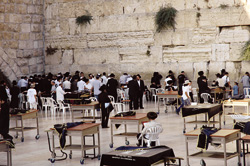 |
| At the Western Wall. Men pray in the area in the left, while women pray in their own section on the right. |
I got lucky the evening I was scheduled to go the Western Wall, it was Sabbath. As I walked towards the Wall, I saw hundreds of Jewish people walking alongside me, both from the new world and old. I believe they come from near and far to be at the Western Wall on a Friday. From the modern to the ultra orthodox, black-hatted Hasidic Jews in beards and side curls.
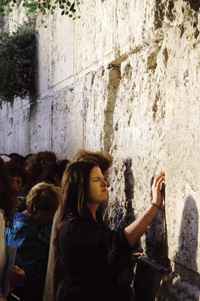 |
| Little notes to God tucked into the fissures of the monumental wall. |
The Wall itself is very awe-inspiring. People lined beneath it, touching and praying, look like little miniatures from afar. The wall is that high. The symbol of Jewish faith and the object of Jewish pilgrimage from all over the world, the Western Wall is the remnant of the western retaining wall of Herod�s Temple Mount. It acquired the name Wailing Wall because during the long exile of the Jewish people from the city they could return only once a year to mourn the destruction of the temple. Throughout the two thousand years of exile, Jews from all parts of the world turned their faces in prayer towards this Wall, in the hope of return.
The Western Wall, which is in the midst of the old city in Jerusalem, has remained intact since the destruction of the second Jerusalem temple (70 CE). It became the most sacred spot in Jewish religious and national tradition. Most of the Western Wall of the temple mount, which was 485 meters long is hidden by the buildings adjoining it.
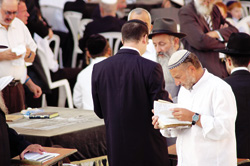 The Western Wall became a permanent feature in Jewish tradition around 1520, either as a result of the immigration of the Spanish exiles or due to the Turkish conquest in 1518. From which time onwards, all literary sources describe it as a prayer place for Jews. According to historical data it was Sultan Salem (Suleiman) the conqueror of Jerusalem, who recovered the wall from underneath the huge dung heap which was hiding it and granted permission to the Jews to hold prayers there. The entrance to the Western Wall area is called the Dung Gate.
The Western Wall became a permanent feature in Jewish tradition around 1520, either as a result of the immigration of the Spanish exiles or due to the Turkish conquest in 1518. From which time onwards, all literary sources describe it as a prayer place for Jews. According to historical data it was Sultan Salem (Suleiman) the conqueror of Jerusalem, who recovered the wall from underneath the huge dung heap which was hiding it and granted permission to the Jews to hold prayers there. The entrance to the Western Wall area is called the Dung Gate.
As far as the recent history goes, with the expansion of the Jewish population in the land of Israel from the beginning of the nineteenth century onward and with the increase in visitors, the popularity of the Western Wall grew among Jews. Its images began to appear in Jewish folkloristic art and later also in modern art drawings and in literature. However the period of the British Mandate saw a lot of bad blood, unrest and riots between the Arabs and the Jews. In fact, from December 1947 after bloody incidents with the Arabs, Jews were no longer able to approach the Wall. After the capitulation of the Jewish Quarter of the Old City in May 1948 Jews were prevented for 19 years from even looking at the Wall from far.
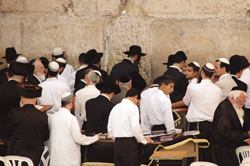 The Wall was liberated on the third day of the six-day war (June 7, 1967) by Israel�s parachutists making a breakthrough. It was an unforgettably emotional event in the history of the Jewish people.
The Wall was liberated on the third day of the six-day war (June 7, 1967) by Israel�s parachutists making a breakthrough. It was an unforgettably emotional event in the history of the Jewish people.
The Moghrabi Quarter was immediately demolished and on the first day of Shavuot, quarter of a million Jews swarmed the place. The entire area in front of the Western Wall was then cleared, levelled and converted into an open space. The lower square near the Wall is the prayer area where one always finds people praying or studying, either singly, or in groups day and night.
What is interesting to note is the surface of the wall from the pavement and upto a man�s height. The colour and feel of the stones are different - that�s because it has been polished by human hands that touched it in prayer through the centuries.
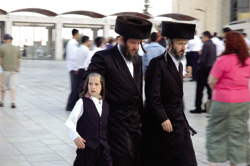 |
| A Sabbath evening at the wall. |
Being at the Wall, watching the Jewish world pray and mingle and observing the endearing custom of inserting small pieces of paper on which wishes are written and tucked into the little spaces in the monumental Herodian stones, made me realize what a unique and special place this was. To top it, I even witnessed a Bar Mitzvah ceremony - something a Jew from every part of the world aspires to perform at the Wall.
Haram esh-Sharif
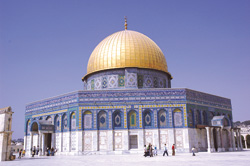 |
| Haram esh-Sharif |
In Islam, there are three holy places in the world: the Ka�bah in Mecca; the Mosque of Prophet Mohammed in Medina; and the Temple Mount, or Haram esh-Sharif in Jerusalem - in that order of status. It is the Quran�s description of Prophet Mohammed�s Night Journey (Sura 17) that has elevated Jerusalem�s position. It tells of Prophet Mohammed, who was sleeping by the Ka�bah, being taken to the Temple Mount in Jerusalem by a Buraq, a winged creature. From there they rose to heaven, on the way meeting good and evil powers. In heaven they saw Abraham, Moses and Jesus, with whom Prophet Mohammed prayed as their leader. Until 624 AD, Muslims prayed in the direction of Jerusalem. It was then decided to face Mecca.
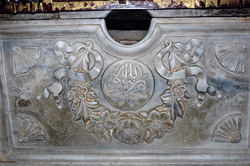 Dominating the Old City, Haram esh-Sharif is a beautiful esplanade, something of a contrast to the noise and congestion of the surrounding narrow streets. Holy to Muslims, Jews, and Christians, the area is considered to be Mt Moriah, the site of Abraham�s sacrifice.
Dominating the Old City, Haram esh-Sharif is a beautiful esplanade, something of a contrast to the noise and congestion of the surrounding narrow streets. Holy to Muslims, Jews, and Christians, the area is considered to be Mt Moriah, the site of Abraham�s sacrifice.
The word moriah is derived from the Hebrew word mora (awe) and can be derived from the Hebrew word orah (light), and some believe when the world was created and God said �Let there be light�, the light first shone over this area.
 The Haram esh-Sharif is a walled area within the old city walls and there are eight access gates, but non-Muslims are allowed to enter only through two: Moors Gate - just south of the Western Wall and the Chain Gate. Entry into the Al Aqsa Mosque and the Dome of the Rock area is only for Muslims.
The Haram esh-Sharif is a walled area within the old city walls and there are eight access gates, but non-Muslims are allowed to enter only through two: Moors Gate - just south of the Western Wall and the Chain Gate. Entry into the Al Aqsa Mosque and the Dome of the Rock area is only for Muslims.
Essentially unchanged for more than thirteen centuries, the Dome of the Rock remains one of the world�s most beautiful and enduring architectural treasures. The golden dome stretches 20 metres across the Noble Rock, rising to an apex more than 35 metres above it. The Quranic verse of Ya-Sin is inscribed across the top in dazzling tile work commissioned in the 16th century.
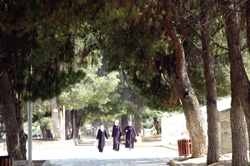 |
| To the Al Aqsa Mosque. |
Built across the earlier location of The Temple, the Dome of the Rock was built by the Muslim ruler Abdel Malik in 688-691. Inspite of numerous earthquakes that took place there no significant damage was caused to the structure because it is situated on a bedrock unlike the Al Aqsa Mosque. This shrine was covered by lead dome from 691 until it was replaced with a gold coloured aluminium cover in 1965. Since that got rusted, the cover was replaced in 1993 with gold.
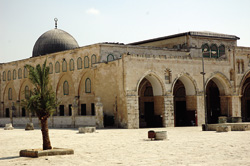 |
| The Holy Al Aqsa. |
More important to the Muslims than the Dome of the Rock is the Al Aqsa Mosque. Muslims maintain that it was built in the 10th century to confirm that Jerusalem is the farthest sanctuary �from where Prophet Mohammed began his night journey� and made his ascent into heaven. Now the country�s largest mosque it is used as the main prayer mosque.
The columns, ceiling, carpets and stained glass windows dominate the mosque�s interiors. The large glacial marble columns courtesy Mussolini and the ceiling�s paint job undertaken by Egypt�s King Farouk were the result of the 1938-42 restoration programme. Nothing much remains of the original construction, which was twice destroyed by earthquakes in its first 60 years.
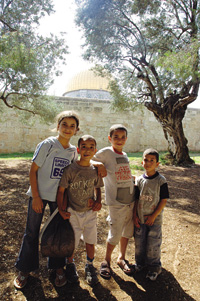 |
| Arab children strike a pose. |
Inside the mosque is the sacred rock upon which Abraham prepared to sacrifice his son. In one corner there is also supposed to be the footprint of Prophet Mohammed and nearby is a box containing what are believed to be hairs from his beard.
An important point to be remembered while entering the Haram area is that you have to be suitably dressed, bare arms and legs are not allowed. Bags are searched on entry and once inside you are expected to proceed quietly towards one of the holiest of holy places. Patrols of plain-clothed Muslim guards walk around and care has to be taken that you don�t wander around into the strictly off-limits areas. A little difficult, because these areas are unmarked. And if you stray even unintentionally you may be lectured or even arrested. Cameras have to be left outside.
The Church of the Holy Sepulchre
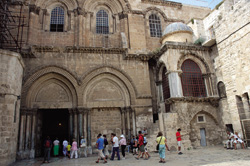 |
| Into the Holy Sepulchre |
The Church of the Holy Sepulchre is among Christianity�s holiest sites and claims to stand on the land where Jesus was crucified, buried and resurrected. It is situated right in the heart of the Christian quarter of the old city.
This has to be the most dynamic church in the country. It is believed by most of the Christian world to encompass such sacred sites as Calvary (Golgoltha), the Holy Sepulchre, and the cistern in which Helena found the True Cross.
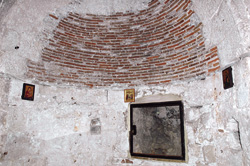 |
| The site where Jesus was crucified |
Today, you find thousands of visitors weaving their way in and out of here but Golgotha was once a bald, rocky hill, situated a few hundred metres outside the Jerusalem walls.
A remarkable edifice built by the crusaders over earlier foundations, the church contains a curious conglomeration of altars, chapels and architectural styles. While waiting in line to enter the Holy Sepulchre, I looked around the Rotunda. High above is a fabulous gold and white dome and on the walls is a series of balconies filled with golden lamps. Having reached the beginning of the line, I entered the atrium, which is called The Chapel of the Angel.
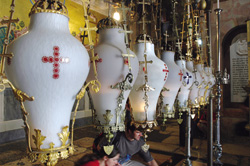 A striking part of the church is the Chapel�s altar. It marks the 11th Station, the site at which Jesus was believed to be nailed to the Cross. A fine example of Renaissance art, the altar�s history began in Florence in 1588 and was then given to the church by Cardinal Medici a few decades later.
A striking part of the church is the Chapel�s altar. It marks the 11th Station, the site at which Jesus was believed to be nailed to the Cross. A fine example of Renaissance art, the altar�s history began in Florence in 1588 and was then given to the church by Cardinal Medici a few decades later.
Entry to the church is open to all communities.
PHOTOGRAPHS BY FARZANA CONTRACTOR





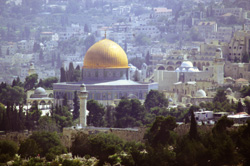






 The Western Wall became a permanent feature in Jewish tradition around 1520, either as a result of the immigration of the Spanish exiles or due to the Turkish conquest in 1518. From which time onwards, all literary sources describe it as a prayer place for Jews. According to historical data it was Sultan Salem (Suleiman) the conqueror of Jerusalem, who recovered the wall from underneath the huge dung heap which was hiding it and granted permission to the Jews to hold prayers there. The entrance to the Western Wall area is called the Dung Gate.
The Western Wall became a permanent feature in Jewish tradition around 1520, either as a result of the immigration of the Spanish exiles or due to the Turkish conquest in 1518. From which time onwards, all literary sources describe it as a prayer place for Jews. According to historical data it was Sultan Salem (Suleiman) the conqueror of Jerusalem, who recovered the wall from underneath the huge dung heap which was hiding it and granted permission to the Jews to hold prayers there. The entrance to the Western Wall area is called the Dung Gate.
 The Wall was liberated on the third day of the six-day war (June 7, 1967) by Israel�s parachutists making a breakthrough. It was an unforgettably emotional event in the history of the Jewish people.
The Wall was liberated on the third day of the six-day war (June 7, 1967) by Israel�s parachutists making a breakthrough. It was an unforgettably emotional event in the history of the Jewish people.


 Dominating the Old City, Haram esh-Sharif is a beautiful esplanade, something of a contrast to the noise and congestion of the surrounding narrow streets. Holy to Muslims, Jews, and Christians, the area is considered to be Mt Moriah, the site of Abraham�s sacrifice.
Dominating the Old City, Haram esh-Sharif is a beautiful esplanade, something of a contrast to the noise and congestion of the surrounding narrow streets. Holy to Muslims, Jews, and Christians, the area is considered to be Mt Moriah, the site of Abraham�s sacrifice.
 The Haram esh-Sharif is a walled area within the old city walls and there are eight access gates, but non-Muslims are allowed to enter only through two: Moors Gate - just south of the Western Wall and the Chain Gate. Entry into the Al Aqsa Mosque and the Dome of the Rock area is only for Muslims.
The Haram esh-Sharif is a walled area within the old city walls and there are eight access gates, but non-Muslims are allowed to enter only through two: Moors Gate - just south of the Western Wall and the Chain Gate. Entry into the Al Aqsa Mosque and the Dome of the Rock area is only for Muslims.





 A striking part of the church is the Chapel�s altar. It marks the 11th Station, the site at which Jesus was believed to be nailed to the Cross. A fine example of Renaissance art, the altar�s history began in Florence in 1588 and was then given to the church by Cardinal Medici a few decades later.
A striking part of the church is the Chapel�s altar. It marks the 11th Station, the site at which Jesus was believed to be nailed to the Cross. A fine example of Renaissance art, the altar�s history began in Florence in 1588 and was then given to the church by Cardinal Medici a few decades later.